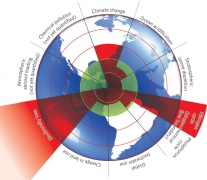
Beyond the boundary
Species extinction is a natural process and would occur without human actions. However, biodiversity loss has accelerated massively in recent years. Species are becoming extinct at a rate that has not been seen since the last global mass-extinction event.
The fossil record shows that the background extinction rate for marine life is 0.1-1 extinctions per million species per year; for mammals it is 0.2-0.5 extinctions per million species per year16. Today, the rate of extinction of species is estimated to be 100 to 1,000 times more than what could be considered natural. As with climate change, human activities are the main cause of the acceleration. Changes in land use exert the most significant effect. These changes include the conversion of natural ecosystems into agriculture or into urban areas; changes in frequency, duration or magnitude of wildfires and similar disturbances; and the introduction of new species into land and freshwater environments. The speed of climate change will become a more important driver of change in biodiversity this century, leading to an accelerating rate of species loss. Up to 30% of all mammal, bird and amphibian species will be threatened with extinction this century.
Biodiversity loss occurs at the local to regional level, but it can have pervasive effects on how the Earth system functions, and it interacts with several other planetary boundaries. For example, loss of biodiversity can increase the vulnerability of terrestrial and aquatic ecosystems to changes in climate and ocean acidity, thus reducing the safe boundary levels of these processes.
There is growing understanding of the importance of functional biodiversity in preventing ecosystems from tipping into undesired states when they are disturbed. This means that apparent redundancy is required to maintain an ecosystem's resilience. Ecosystems that depend on a few or single species for critical functions are vulnerable to disturbances, such as disease, and at a greater risk of tipping into undesired states. Read the whole online Nature article here http://www.nature.com/nature/journal/v461/n7263/full/461472a.html
This Feature is an edited summary of a longer paper available at the Stockholm Resilience Centre (http://www.stockholmresilience.org/planetary-boundaries ). To facilitate debate and discussion, there are simultaneously published a number of linked Commentaries from independent experts in some of the disciplines covered by the planetary boundaries concept. Please note that this Feature and the Commentaries are not peer-reviewed research. This Feature, the full paper and the expert Commentaries can all be accessed from http://tinyurl.com/planetboundaries.

